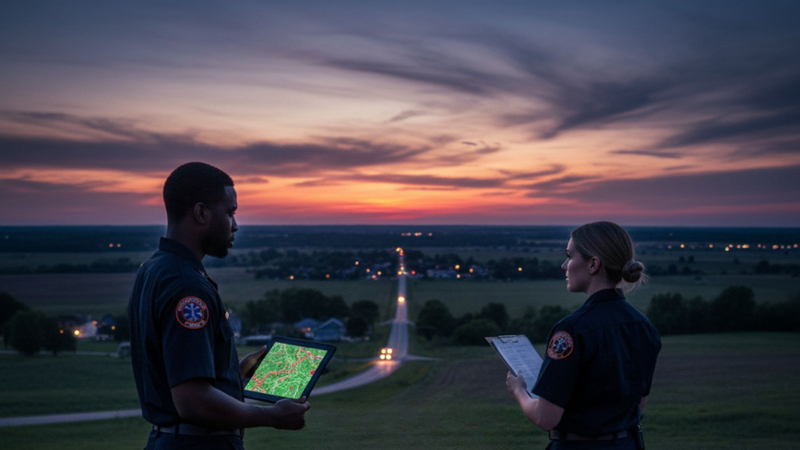Blog
EMS - A Dynamic Healthcare Delivery Team
Lifelines in the Landscape: Addressing the Challenges Facing EMS Providers in Rural Mississippi
Emergency Medical Service providers are the bedrock of community health, yet those serving rural Mississippi face unique and significant obstacles daily. The Mississippi Center for Advancement of Prehospital Medicine (MSCAPM) is dedicated to understanding these challenges and championing the solutions that support our frontline heroes. This article explores the distinct hurdles our rural EMS professionals overcome to provide critical care across our great state.
moreYour Path to a Rewarding Career: A Step-by-Step Guide to EMT Certification
Are you ready to answer the call and serve your community? The Mississippi Center for Advancement of Prehospital Medicine (MSCAPM) is here to guide aspiring heroes like you. This guide outlines the essential emergency medical technician requirements and shows you exactly how to get your EMT certification so you can begin a fulfilling career serving fellow Mississippians.
moreEMS at the Crossroads: How Mississippi Can Lead a Rural Healthcare Revolution a blog post
Mark Galtelli
Introduction: The Opportunity in Front of Us
The One Big Beautiful Bill Act (H.R. 1), passed on July 4, 2025, fundamentally changes the healthcare funding landscape. While it significantly reduces Medicaid funding, it also brings unprecedented federal support for rural healthcare. Central to it is the Rural Health Transformation Program, a $50 billion fund, $10 billion annually, for states that submit and receive approval for transformation plans (Holland & Knight, 2025; Rural Health Transformation Program Summary, 2025). Mississippi stands to receive at least $100 million, and potentially another $100 million, if the state demonstrates measurable progress in efficiency, patient outcomes, and technology adoption (Senator Hyde-Smith, 2025; Rural Health Transformation Program Summary, 2025). This funding is not open-ended. It comes with expectations of rigor, accountability, and sustainability. Projects must show results and a pathway to stand on their own once federal support tapers off. Notably, EMS has been designated as a priority within the state’s funding stream. This creates a chance to deliver lasting transformation and modernization for EMS.
Linking to the Bigger Picture: EMS’s Evolving Role
moreThe Future of EMS
Mark Galtelli
The Future of EMS: A Reality Check and a Path Forward
It is time for a reality check in Emergency Medical Services (EMS). The word “emergency” has defined us for fifty years, yet it no longer captures the full scope of what EMS does. Think of it this way: imagine a national product that launched half a century ago and has carried the same name, the same logo, and the same marketing ever since. Over time, the world changed, the market changed, and consumer needs changed, but the brand stayed frozen. You cannot raise the price, expand the market, or grow the product because the public is fixated on what it was in 1974. If you engaged a modern marketing firm, their advice would be simple: change the logo, update the name, reframe the brand, and launch again with an identity that reflects today’s reality, not yesterday’s. EMS is in that exact position. We need a new identity that represents what we actually do: dynamic, integrated prehospital health care delivery that supports every corner of the health system.
EMS is the Green Beret of healthcare. A Green Beret operates in a small team with very focused skills and access to the most specialized resources. Their missions frequently take place in politically sensitive environments, demanding not only exceptional training but also cultural awareness and adaptability. Their work includes training, advising, and assisting local communities, often in unstable territory. They do not just fight battles; they build capacity, empower local communities, and create stability where none existed. In many ways, EMS functions the same way within healthcare. We manage chaotic environments with focused skills, advanced tools, and the ability to operate under intense pressure. We integrate into communities, teach, identify resources, and fill critical healthcare gaps. Yes, we are first responders, but at our best, we are healthcare providers who are force multipliers for the healthcare system. Yet, unlike the Green Beret, our identity and our systems are trapped in the past.
more#IamEMS
Mark Galtelli
Emergency Medical Services (EMS) began with a clear mission: to respond to the growing number of vehicle crashes that claimed lives on American roads. We rapidly stood up EMS services across the country. EMS met that challenge and effectively helped reduce trauma related mortality. We also began to fill an important void in the healthcare system and proved the value of rapid, skilled care outside the walls of a hospital.
From there, our role grew. We moved beyond trauma to medical emergencies of every kind. We learned medicine, developed new skills and interventions, and expanded our scope. What started as a dependent role requiring direct physician input has become a profession where independent clinical and professional judgment is expected. Today, EMS professionals work in dynamic environments where written guidelines are interpreted, adapted, and applied in real time to deliver high-quality care based on the patient’s needs.
EMS has embedded itself into communities. We work in small, specialized teams that can operate anywhere, anytime. While we continue to fill the role of first responders, through our response to emergencies and disasters, our role has become much broader. We are healthcare providers delivering high quality care in these dynamic and unique environments. You find EMS supporting tactical operations. We manage critical interfacility transfers. We provide frontline primary care in underserved areas. We staff clinics, urgent care centers, and emergency departments. Almost every part of the healthcare systems relies on EMS to some degree.
more

